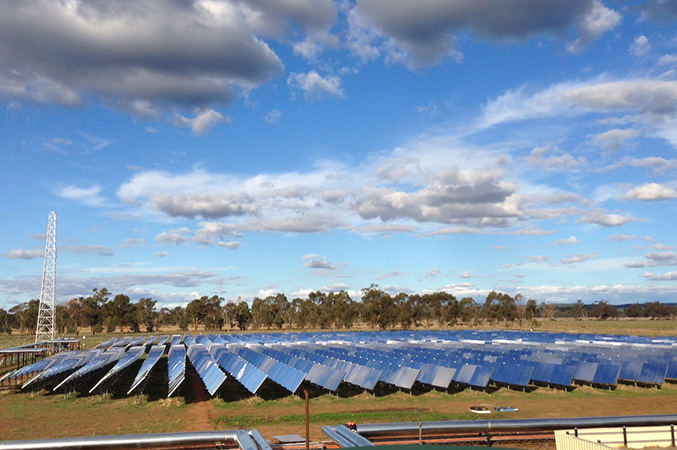An accounting requirement has led to the unexpected $16.5 million write-down in recoverable value of the recently completed and successfully energised 50 MW Jemalong Solar Project (JSP), Genex Power’s 2021 Annual Report reveals.
“The non-cash impairment has no impact on either JSP or Genex’s funding,” assures Genex CEO James Harding in the report, “and is not reflective of the operational performance of the asset.”
On the contrary, he writes, “the project has been contributing strong revenues since energisation and continues to remain a valuable cash generating asset for the Group.”
Genex Power is of course the developer of the Kidston combined solar, wind and pumped hydro proposal for the former gold mine of the same name. The 50 MW first stage of its solar ambitions, KS1, contributed $13.3 million in revenue over the past reporting year, and in April this year Genex Power achieved financial close on the 250 MW K2-Hydro component of its Kidston Clean Energy Hub, an important renewable generation and storage addition to the North Queensland grid.
JSP was acquired by Genex Power from Vast Solar in March 2019, and the purchase was funded on a portfolio basis, together with refinancing of the company’s KS1 project.
Smart financing gets complex
Portfolio finance gave JSP a favourable funding structure, which helped drive the acquisition to completion.
Genex subsequently proceeded with the development of the project, with Beon Energy Solutions as its engineering, procurement and construction (EPC) and operations and maintenance (O&M) contractor.
Energised in December last year, JSP is now fully commissioned and operating as a merchant generator in the National Electricity Market — and therein, it seems lies the fly in the accounting ointment.
How to trigger an impairment assessment
Firstly, as a merchant generator, the company receives the spot price for electricity generated by JSP (as well as revenue from the sale of Large-Scale Generation Certificates). The need for an impairment assessment was triggered by a decrease in wholesale electricity prices over the past financial year, and for impairment testing, writes Harding, “the application of the accounting standards require JSP to be assessed on a standalone basis.
“As such, the assumptions that can be made around funding structure and cost of funding are restrictive,” and “such assumptions do not reflect the actual commercial parameters under which JSP operates.”
Genex Power’s second generating asset, JSP which is located in Forbes in central west New South Wales provides geographic diversification to the company’s portfolio.
Together, JSP and KS1 generate some 267,000 MWh of clean energy each year, offsetting about 250,000 tonnes of CO2 and producing enough energy to power up to 41,660 average Australian homes.
Back to the future
The annual report confirms that the company is now focused on delivering its K2-Hydro project, with energisation scheduled to commence in late 2024.
A key enabler of K2, the first new pumped hydro project to be delivered in Australia in 40 years, was the Queensland Government’s $147 million Transmission Line Funding package.
Together with the connection agreement signed with Powerlink in March, the funding enabled work to commence on development of a new 186km 275 kV single-circuit transmission line from Kidston to the site of a new switching station which will be constructed at Mt Fox.
Transmission is already a given for Genex’s likely 50 MW Bouldercombe Battery Project (BBP) to be situated within the boundary of Powerlink’s Bouldercombe substation near the Queensland city of Rockhampton.
A connection offer is expected in Q2 of next year. If financial close is achieved shortly thereafter, BBP will demonstrate the flexibility and speed to completion of battery storage technology by becoming operational almost two years before K2, at the beginning of 2023.
The project was identified as part of a strategy to diversify Genex’s footprint in energy storage, and leverage the expertise it has developed in renewable energy storage as part of bringing K2 to build stage.
BBP is intended to operate on an arbitrage and frequency control ancillary services (FCAS) model, and will have the ability to bid into all FCAS markets.
In the meantime, Harding expects JSP, earning a more than a million dollars a month in revenues on the basis of improved wholesale electricity prices, “will provide a step change in revenue and cashflow generation for the Company from FY22 onwards”.
This content is protected by copyright and may not be reused. If you want to cooperate with us and would like to reuse some of our content, please contact: editors@pv-magazine.com.









By submitting this form you agree to pv magazine using your data for the purposes of publishing your comment.
Your personal data will only be disclosed or otherwise transmitted to third parties for the purposes of spam filtering or if this is necessary for technical maintenance of the website. Any other transfer to third parties will not take place unless this is justified on the basis of applicable data protection regulations or if pv magazine is legally obliged to do so.
You may revoke this consent at any time with effect for the future, in which case your personal data will be deleted immediately. Otherwise, your data will be deleted if pv magazine has processed your request or the purpose of data storage is fulfilled.
Further information on data privacy can be found in our Data Protection Policy.